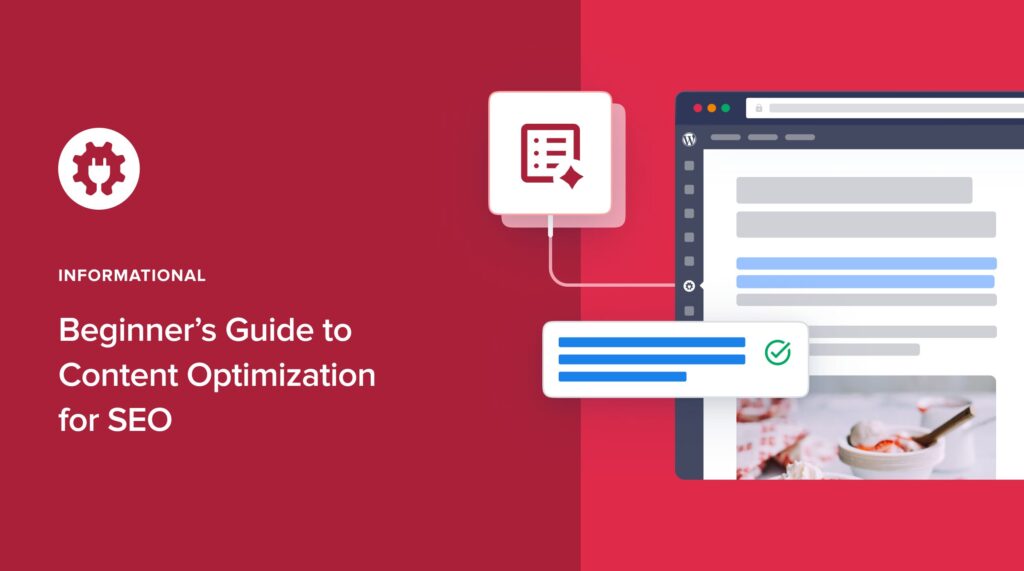Looking for a beginner-friendly guide to content optimization?
Content optimization is a crucial aspect of search engine optimization (SEO) that ensures your content is meaningful and search engine friendly. It also results in better search rankings, more traffic to your site, and higher engagement rates.
In this article, we’ll walk you through some of the most impactful content optimization strategies and tips you can use to create effective content.
In This Article
What is Content Optimization?
Content optimization refers to the process of ensuring that your content is written and presented in a way that can reach the largest possible target audience. When optimized for SEO, content can improve its chances of appearing in search engine results pages (SERPs), thereby increasing organic traffic.
Content optimization involves strategically incorporating relevant keywords, improving readability, and structuring content to meet both user needs and search engine requirements. This guide will show you how to do that.
Benefits of Content Optimization
Before we dive into the mechanics of content optimization, let’s briefly look at its benefits:
- Increased organic Traffic: Optimized content ranks higher in search results, leading more users to your site. This type of traffic, called organic traffic, costs less to acquire than paid search traffic and is more engaged.
- Improved user experience (UX): Well-structured and informative content is easier to interact with and digest, keeping users engaged and coming back for more.
- Enhanced brand credibility: High-ranking content positions you as an authority in your niche.
- Better conversion rates: Optimized content compels users to take desired actions, like subscribing or buying. This is why good quality content should be part of every site’s conversion rate optimization (CRO) plan.
- Long-term SEO benefits: By regularly updating and improving your content, you can maintain and enhance your SEO performance over time, ensuring sustained organic traffic and growth.
Guide to Content Optimization for SEO
Ready to optimize your content for better search rankings and increased traffic?
Here are some guidelines to follow:
Use the Right Content Optimization Tools
To effectively optimize your content for SEO, you need to use the right content optimization tools. And at AIOSEO, we have 2 such tools:
- All In One SEO (AIOSEO)
- SEOBoost
Here’s a brief summary of the content optimization capabilities of each:
Using AIOSEO for Content Optimization
One of the first content optimization tips is to ensure you have the right SEO tool. For WordPress users, there’s no better tool than All In One SEO (AIOSEO).

AIOSEO is a powerful WordPress SEO plugin boasting 3+ million active users. Many marketers and bloggers trust the plugin to help them boost their search engine rankings and traffic. That’s because the plugin has many powerful features and modules designed to help you properly configure your SEO settings.
When it comes to content optimization, some of the modules you’ll find helpful include:
Writing Assistant
Writing Assistant is AIOSEO's revolutionary tool that acts as your personal SEO guide to help ensure your content is primed to rank well on search engines.
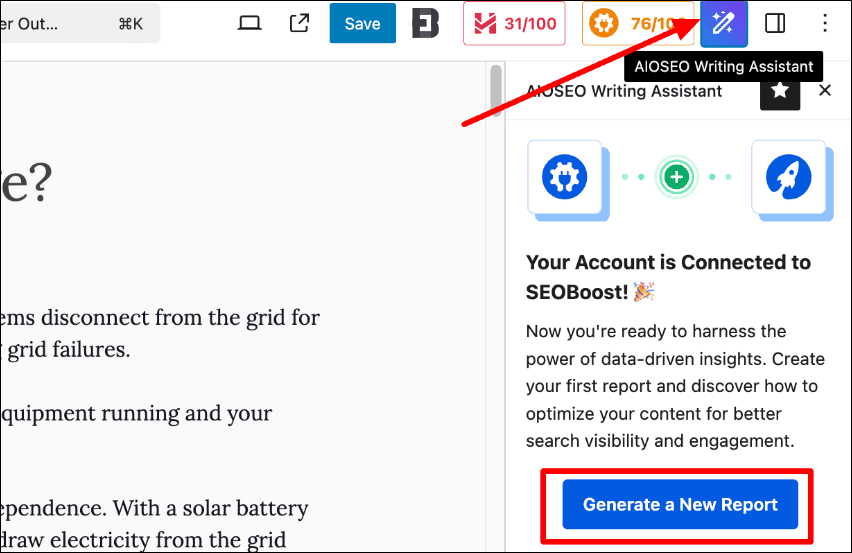
Writing Assistant grades your content according to the top ranking pages targeting the same keyword as your content. The best aspect of Writing Assistant is that it works on both existing content and the content you're currently writing. It also gives you suggestions on how to use the LSI keywords it suggests.
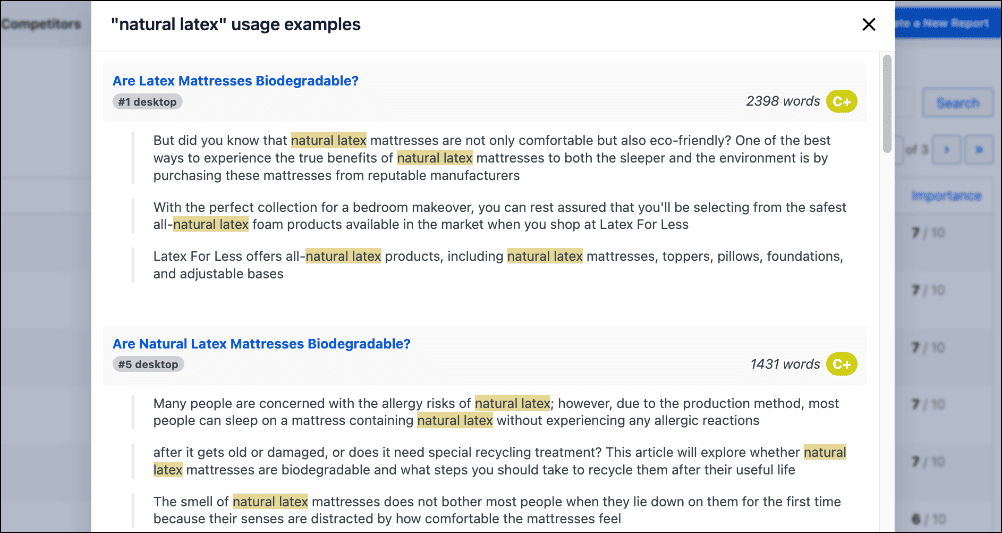
Writing Assistant is free for all plans. However, you need an SEOBoost account, as most optimization data comes from there.
If you want to win at SEO content writing, then this is a must-have tool to have in your toolbox.
TruSEO Analysis
AIOSEO’s TruSEO Onpage Analysis gives you a score of how well-optimized your content is.
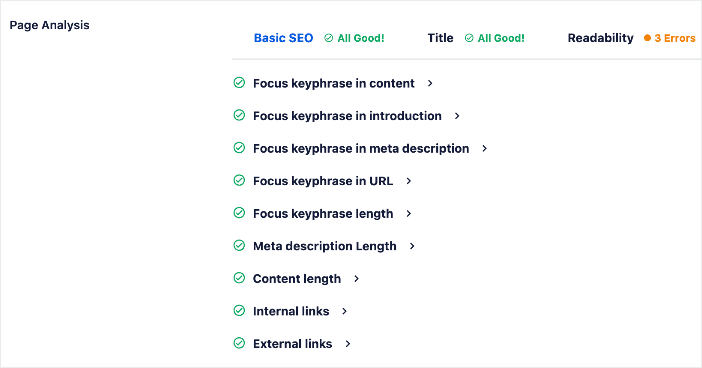
It even gives you recommendations for improving your it.
TruSEO Highlighter
AIOSEO’s TruSEO Highlighter is a great tool that helps you nail your on-page SEO on the fly.

The TruSEO Highlighter analyzes your page content and makes readability recommendations. It also highlights items that need fixing, including:
- Subheading distribution
- Passive voice
- Transition words
This cool feature also gives you recommendations for fixing any on-page SEO errors it finds.
Link Assistant
Link Assistant is a tool that crawls your site and gives a report of all the links on your site.
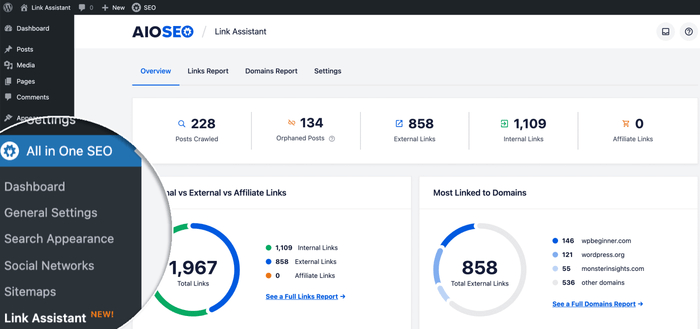
This is important because internal links play a huge role in content optimization. They help distribute link juice, improve crawling and indexing, and help keep readers on your site longer.
Link Assistant gives you a Links Report that shows you internal linking suggestions. It also shows you the orphan pages on your site.

The best part is that you don’t even need to open a post to add the links. You can just do so from the Link Assistant dashboard.
Search Statistics (Monitoring Content Decay)
Search Statistics is AIOSEO’s Google Search Console integration. It helps you see important organic search metrics right in your WordPress dashboard. It also has a neat trick up its sleeves—it can help you spot content decay, which is the gradual loss of traffic and rankings of a piece of content.

Content optimization is the best way to combat content decay.
We’ll go into more detail on this in a moment.
For step-by-step instructions on how to install AIOSEO, check our detailed installation guide.
SEOBoost: The Most Comprehensive Content Optimization Tool
SEOBoost is another content optimization tool to consider. This revolutionary tool scrapes SERPs and pulls up the main keywords in the top-ranking posts.

SEOBoost is a full-suite content management platform you can use to:
- Create content briefs and outlines
- Create topic reports
- Conduct content audits
- Use AI to speed up content optimization
It also gives recommendations on how to better optimize your content.
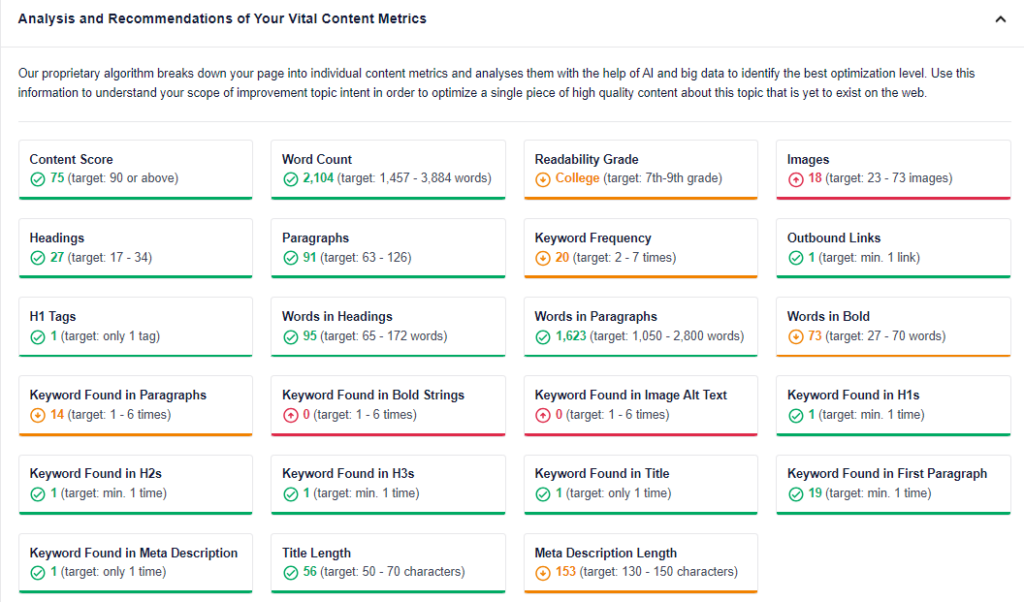
Check out the full power of SEOBoost here.
Understand Your Audience and Goals
Identifying who you are creating content for is the first step in optimization. Understanding your audience's demographics, interests, and pain points allows you to create content that resonates with them.
You should also have clear goals for your content optimization strategy. Specific, measurable, achievable, relevant, and timebound (SMART) goals are essential for guiding your content strategy. Whether it's increasing traffic, generating leads, or boosting brand awareness, setting clear objectives helps you measure success and adjust strategies as needed.
Keyword Research and Planning
Keyword research is critical to most digital marketing disciplines, including content marketing. Whether you want to optimize existing content or new content, you’ll need to know which keywords to target.
Several tools can help you identify the best keywords for your content. Popular options include:
- LowFruits: Helps you find low competition, high potential keywords and content gaps on SERPs.
- Google Keyword Planner: Provides search volume and competition data for keywords.
- Semrush: Offers in-depth keyword research and competitor analysis capabilities.
- Ahrefs: Provides detailed insights into keyword difficulty and search trends.
These tools provide insights into keyword volume, competition, and trends. Tools like Semrush even go a step further by showing you the search intent behind the keyword.
Identifying Relevant Keywords
Choosing the right keywords involves finding a balance between search volume and competition. Focus on keywords that are relevant to your audience and achievable, given your site's current authority. If you’re just starting out, try to avoid those with a high keyword difficulty score if possible. Instead, you should focus on low-competition keywords, as you’ll likely rank faster for these.
Writing Optimized Content
Once you've identified your keywords, it's time to create content. 2 main elements to focus on here include:
Content Structure and Organization
A clear and logical content structure makes it easier for both users and search engines to understand your content. Use headings, subheadings, bullet points, and paragraphs to organize your content effectively. Aim for scannable content, as it’s easier to digest.
Best Practices for Keyword Placement
Strategic keyword placement is another vital element of content optimization. Examples of places to include your keywords include:
- Titles and headings
- Metadata like SEO titles and meta descriptions
- URLs
- Header tags
- Body
However, place your keywords naturally and avoid keyword stuffing, as it can lead to overoptimization, which Google frowns upon. Aim for a natural flow with a keyword density of at least 0.5%. This is another content optimization element AIOSEO helps you with.

The TruSEO Analysis module helps ensure your keyword density isn’t too low.
Focus on Content Quality
High-quality content that is informative, engaging, and error-free is more likely to attract and retain readers. To improve content quality:
- Include relevant statistics and facts
- Leverage case studies if possible
- Use proper language and grammar
- Conduct thorough research
- Ensure your content is original and adds value
Content quality also fosters trust and credibility. When users encounter well-researched and informative content, they are more likely to view your site as a reliable source of information. This trust can translate into increased brand loyalty and higher conversion rates, as users are more inclined to take action based on content they find trustworthy.
Besides content quality, you should also aim to prove that the author is qualified to write on the topic. This is what Google calls E-E-A-T, which stands for:
- Experience
- Expertise
- Authoritativeness
- Trustworthy
Fortunately, you don’t have to break a sweat to demonstrate Google E-E-A-T signals. You can easily do so with AIOSEO’s Author SEO module. Besides helping you send signals to search engines that you’re qualified to talk about the subject, it also helps you manage your author bio.
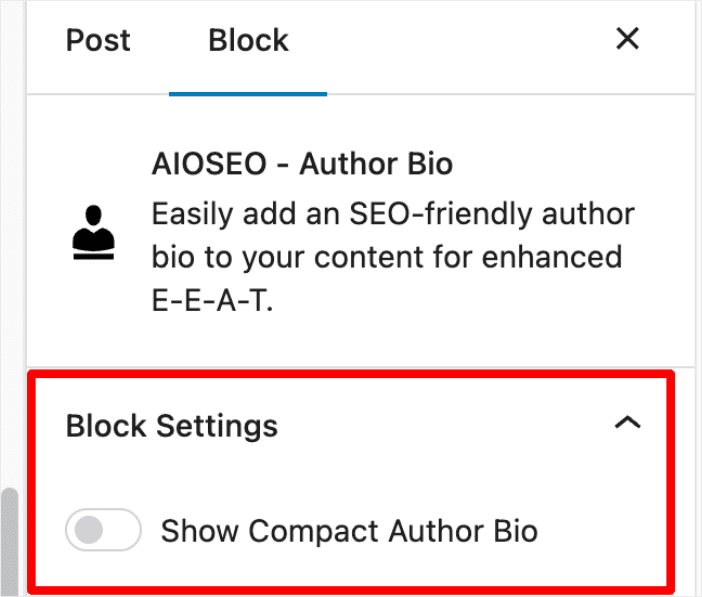
Because the author bios are SEO-friendly, this enhances your online visibility.
Content Optimization for User Experience
Besides quality, you should also optimize your content for readability. Readability refers to how easy it is for people to read and understand your content. It's an important aspect of content optimization, especially for SEO and user experience purposes.
If you’re an AIOSEO user, you can use the plugin’s TruSEO Analyzer to help you quickly optimize for readability.
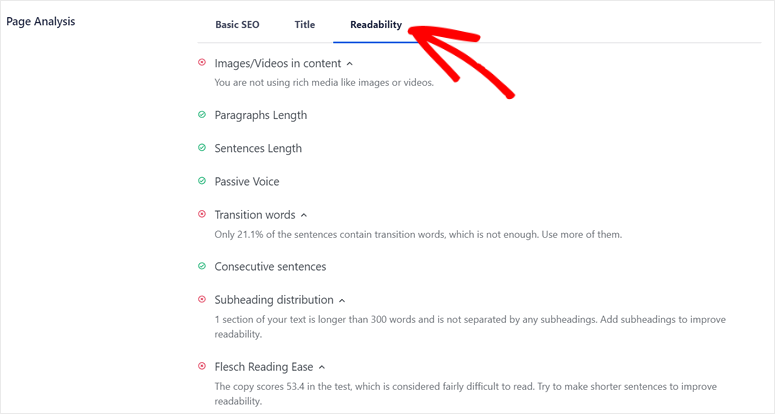
Some tips on improving your readability include:
- Use short paragraphs, bullet points, and white space
- Incorporate relevant visuals like images, videos, or infographics
- Avoid long run-on sentences
- Include transition words
Check out our guide on improving your readability for more details.
The Place of Internal Linking in Content Optimization
Internal links are hyperlinks that connect one page of a website to another page within the same website. They are an important element of site structure and SEO strategy. Some tips for effective internal linking include:
- Use descriptive anchor text
- Link to relevant pages within your site
- Avoid orphan pages
- Use a logical structure
- Prioritize important pages
Remember, internal linking plugins like AIOSEO can help speed this up and ensure your internal linking strategy contributes to your SEO performance. Coupled with the Cornerstone Content feature, you can strategically create topic clusters, an essential component of building authority and boosting your SEO.
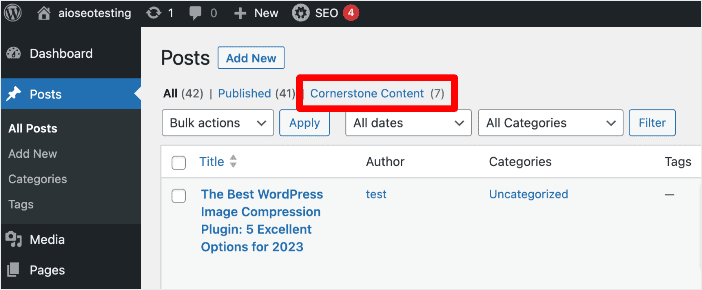
Implementing these internal linking best practices as you optimize your content is essential to helping you push your content higher on SERPs.
Advanced Content Optimization Techniques
Content Freshness and Updates
Regularly updating your content keeps it relevant and can improve your rankings. Search engines favor fresh content, and periodic updates show that your site is active and well-maintained. This was revealed in some Google search algorithm leaked documents, making it a confirmed ranking factor.

Content updates should definitely be part of your content optimization strategy if you want your content to continue bringing results in the long term. A few tips to help keep your content fresh include:
- Run content audits using tools like SEOBoost
- Revisit old posts and add new information
- Update statistics and data
- Refresh visuals and multimedia elements
Doing this will make your content evergreen and relevant to your readers, despite being originally published a while back. This content optimization hack will ensure you continue to reap the benefits of organic traffic without putting in much effort and resources.
Measuring and Analyzing Performance
Monitoring the performance of your content optimization strategy is crucial to understanding what works and what needs adjustments. To track your efforts effectively, you can use tools like Google Analytics and Google Search Console. For WordPress users, AIOSEO’s Search Statistics module provides a powerful integration with Google Search Console to track keyword rankings, content performance, and other important SEO metrics with just one click.
On a more granular level, here are some of the important metrics to track after optimizing your content:
1. Monitor Overall SEO Metrics
The Dashboard section provides an overview of vital metrics like Search Impressions, Total Clicks, Average CTR, and Average Position. It also shows the performance of keywords at different positions in the Keyword Positions section.

2. Monitor Content Performance
The Content Performance report shows how your posts and pages perform on SERPs.

It includes three main reports:
- Top Pages: Shows your best-performing pages.
- Top Losing: Shows the pages losing rankings the most.
- Top Winning: Shows content gaining higher rankings on SERPs.
The report provides metrics like Clicks, Impressions, Position, and Diff (change in position) for each page, giving you deep insights into what’s happening to your content on SERPs.
3. Monitor Keyword Performance
The Keyword Rankings report gives insights into how your content is performing for your target keywords.

It includes the same metrics as the Content Performance report but for your specific keywords.
4. Monitor for Content Decay
You can use Search Statistics to monitor content decay, which is the gradual decrease in organic performance for content. To do so, head to the Content Performance tab to see which articles are performing well and which are losing rankings.

Once you identify decaying content, you can stop it, improve your rankings, and boost your organic traffic.
Regularly reviewing and adjusting your plan ensures you achieve your desired results. You should also schedule time to refresh your content to ensure it continues to perform well.
Content Optimization: Your FAQs Answered
What is content optimization?
Content optimization is the process of refining your content to rank higher in search and resonate with your target audience.
Why is optimizing content important?
Optimizing content is crucial to attract organic traffic, establish authority, and ultimately achieve your business goals.
What does optimizing your content help improve?
Optimized content improves search ranking, user engagement, brand credibility, and conversion rates.
We hope this post has helped you understand what content optimization is and how to implement it on your site. You may also want to check out other articles on our blog, like our guide to common SEO mistakes to avoid or our article on the benefits of SEO for small businesses.
If you found this article helpful, then please subscribe to our YouTube Channel. You’ll find many more helpful tutorials there. You can also follow us on Twitter, LinkedIn, or Facebook to stay in the loop.
Disclosure: Our content is reader-supported. This means if you click on some of our links, then we may earn a commission. We only recommend products that we believe will add value to our readers.
